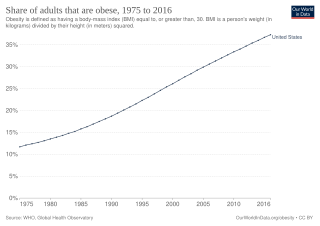
A soft drink is any water-based flavored drink, usually but not necessarily carbonated, and typically including added sweetener. Flavors used can be natural or artificial. The sweetener may be a sugar, high-fructose corn syrup, fruit juice, a sugar substitute, or some combination of these. Soft drinks may also contain caffeine, colorings, preservatives and other ingredients.

The Center for Science in the Public Interest (CSPI) is a Washington, D.C.-based non-profit watchdog and consumer advocacy group that advocates for safer and healthier foods.
A fat tax is a tax or surcharge that is placed upon fattening food, beverages or on overweight individuals. It is considered an example of Pigovian taxation. A fat tax aims to discourage unhealthy diets and offset the economic costs of obesity.
Workplace wellness, also known as corporate wellbeing outside the United States, is a broad term used to describe activities, programs, and/or organizational policies designed to support healthy behavior in the workplace. This often involves health education, medical screenings, weight management programs, and onsite fitness programs or facilities. Recent developments in wearable health technology have led to a rise in self-tracking devices as workplace wellness. Other common examples of workplace wellness organizational policies include allowing flex-time for exercise, providing onsite kitchen and eating areas, offering healthy food options in vending machines, holding "walk and talk" meetings, and offering financial and other incentives for participation. Over time, workplace wellness has expanded from single health promotion interventions to describe a larger project intended to create a healthier working environment.
The Dietary Guidelines for Americans (DGA) provide nutritional advice for Americans who are healthy or who are at risk for chronic disease but do not currently have chronic disease. The Guidelines are published every five years by the US Department of Agriculture, together with the US Department of Health and Human Services. Notably, the most recent ninth edition for 2020–25 includes dietary guidelines for children from birth to 23 months. In addition to the Dietary Guidelines per se, there are additional tools for assessing diet and nutrition, including the Healthy Eating Index (HEI), which can be used to assess the quality of a given selection of foods in the context of the Dietary Guidelines. Also provided are additional explanations regarding customization of the Guidelines to individual eating preferences, application of the Guidelines during pregnancy and infancy, the USDA Nutrition Evidence Systematic Review, information about the Nutrition Communicators Network and the MyPlate initiative, information from the National Academies about redesigning the process by which the Dietary Guidelines for Americans are created, and information about dietary guidelines from other nations.

Obesity is common in the United States and is a major health issue associated with numerous diseases, specifically an increased risk of certain types of cancer, coronary artery disease, type 2 diabetes, stroke, and cardiovascular disease, as well as significant increases in early mortality and economic costs.

A sugary drink tax, soda tax, or sweetened beverage tax (SBT) is a tax or surcharge designed to reduce consumption of sweetened beverages. Drinks covered under a soda tax often include carbonated soft drinks, sports drinks and energy drinks. This policy intervention is an effort to decrease obesity and the health impacts related to being overweight, however the medical evidence supporting the benefits of a sugar tax on health is of very low certainty. The tax is a matter of public debate in many countries and beverage producers like Coca-Cola often oppose it. Advocates such as national medical associations and the World Health Organization promote the tax as an example of Pigovian taxation, aimed to discourage unhealthy diets and offset the growing economic costs of obesity.
Based in Washington, D.C., Leadership for Healthy Communities is a $10-million national program of the Robert Wood Johnson Foundation designed to engage and support local and state government leaders nationwide in their efforts to advance public policies that support healthier communities and prevent childhood obesity. The program places an emphasis on policies with the greatest potential for increasing sustainable opportunities for physical activity and healthy eating among children at highest risk for obesity, including African-American, Latino, American Indian and Alaska Native, Asian-American and Pacific Islander children living in lower-income communities. The foundation's primary goal is the reversal of the childhood obesity epidemic by 2015.

Obesity in China is a major health concern according to the WHO, with overall rates of obesity around 5% for the country, but it varies from province to province. Around 21% of the adult population has a BMI of above 23.

Let's Move! is a public health campaign in the United States led by former First Lady Michelle Obama. The campaign aimed to reduce childhood obesity and encourage a healthy lifestyle in children.

Obesity in the Middle East and North Africa is a notable health issue. Out of the fifteen fattest nations in the world as of 2014, 5 were located in the Middle East and North Africa region.

The Healthy, Hunger-Free Kids Act of 2010 is a federal statute signed into law by President Barack Obama on December 13, 2010. The law is part of the reauthorization of funding for child nutrition. It funded child nutrition programs and free lunch programs in schools for 5 years. In addition, the law set new nutrition standards for schools, and allocated $4.5 billion for their implementation. The new nutrition standards were a centerpiece of First Lady Michelle Obama's Let's Move! initiative to combat childhood obesity. In FY 2011, federal spending totaled $10.1 billion for the National School Lunch Program. The Healthy, Hunger-Free Kids Act allows USDA, for the first time in 30 years, opportunity to make real reforms to the school lunch and breakfast programs by improving the critical nutrition and hunger safety net for millions of children. Healthy, Hunger-Free Kids Act and Michelle Obama were a step in transforming the food pyramid recommendation, which has been around since the early 1990s, into what is now known as "MyPlate".
Nutrition education is a set of learning experiences designed to assist in healthy eating choices and other nutrition-related behavior. It includes any combination of educational strategies, accompanied by environmental supports, designed to facilitate voluntary adoption of food choices and other food and nutrition-related behaviors conducive to health and well-being. Nutrition education is delivered through multiple venues and involves activities at the individual, community, and policy levels. Nutrition Education also critically looks at issues such as food security, food literacy, and food sustainability.
The Oklahoma Governor's Council on Physical Activity and Sport is a council within the office of the governor of Oklahoma for the purpose of. In cooperation with the President's Council on Fitness, Sports, and Nutrition, originated in 1991 by Executive Order of then Governor David Walters.
The DC Healthy Schools Act was passed in May 2010 in order to improve the health of students in the District of Columbia. It was enacted in response to both the obesity epidemic in DC and childhood hunger. It targets all DC Public and Charter Schools. The bill was introduced by Councilwoman Mary M. Cheh, passed unanimously and signed into law by Mayor Adrian Fenty.

A sweetened beverage is any beverage with added sugar. It has been described as "liquid candy". Consumption of sweetened beverages has been linked to weight gain, obesity, and associated health risks. According to the CDC, consumption of sweetened beverages is also associated with unhealthy behaviors like smoking, not getting enough sleep and exercise, and eating fast food often and not enough fruits regularly.

Obesity and the environment aims to look at the different environmental factors that researchers worldwide have determined cause and perpetuate obesity. Obesity is a condition in which a person's weight is higher than what is considered healthy for their height, and is the leading cause of preventable death worldwide. Obesity can result from several factors such as poor nutritional choices, overeating, genetics, culture, and metabolism. Many diseases and health complications are associated with obesity. Worldwide, the rates of obesity have nearly tripled since 1975, leading health professionals to label the condition as a modern epidemic in most parts of the world. Current worldwide population estimates of obese adults are near 13%; overweight adults total approximately 39%.
This article summarizes healthcare in Texas. In 2022, the United Healthcare Foundation ranked Texas as the 38th healthiest state in the United States. Obesity, excessive drinking, maternal mortality, infant mortality, vaccinations, mental health, and limited access to healthcare are among the major public health issues facing Texas.
Mary Story is Professor of Global Health and Community and Family Medicine, and associate director of Education and Training, Duke Global Health Institute at Duke University. Dr. Story is a leading scholar on child and adolescent nutrition and child obesity prevention.

Chile's food labelling and advertising law, formally titled Ley 20.606, sobre la composición de los alimentos y su publicidad establishes a regulatory framework on food security and healthy food with the intention of guiding consumers towards behaviour patterns that promote public health. After the 2012 law was enacted, its accompanying regulations came into full force on June 27, 2016. Andrew Jacobs, writing for The New York Times, has characterized this measure as "the world’s most ambitious attempt to remake a country’s food culture" and suggests it "could be a model for how to turn the tide on a global obesity epidemic that researchers say contributes to four million premature deaths a year."











